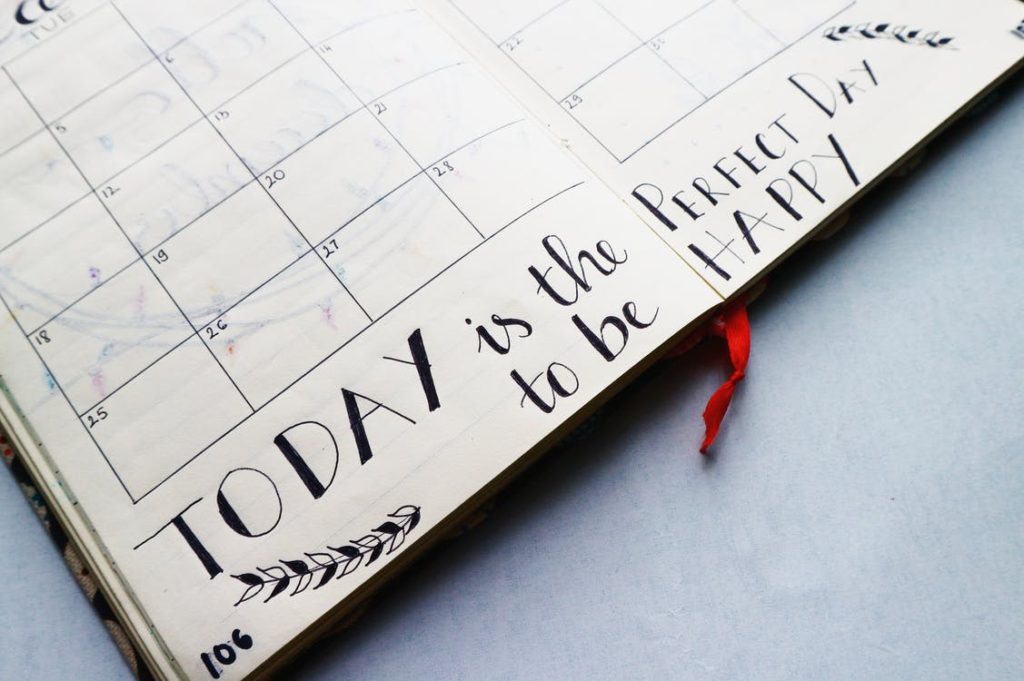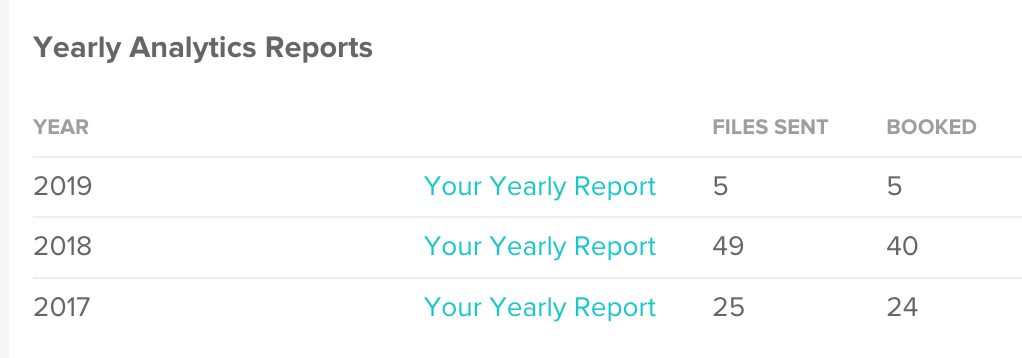Last Updated: February 14th, 2020
Let’s face it, choosing wedding photography as a career option is very difficult.
One of the hardest things we’ve experienced first-hand is how tough it can be financially. Between significant investments into professional quality photography gear and working long hours to run the business side of things and take photos for people – it is tough stuff.
We’re not saying these things to scare you – because we enjoy every minute of it (yes: even the hard parts), and it can be extremely rewarding if done well.
Even if you are a wedding photographer already starting to get some consistent bookings on your calendar, you may notice that they tend to skew towards one or two seasons of the year.
With this in mind, we want to talk to you today about how you can survive the slow season as a wedding photographer!
What our wedding photography bookings looked like – 3 years of progress
 The first couple of years of our wedding photography business, we began to book more and more. We’ll be the first to admit – getting these bookings was not always easy, and required extensively building a credible reputation and portfolio.
The first couple of years of our wedding photography business, we began to book more and more. We’ll be the first to admit – getting these bookings was not always easy, and required extensively building a credible reputation and portfolio.
In the 1st year, we had 5 weddings booked – all in the fall months. Sure, we filled in on a few weddings as second shooters for other photographers during different seasons, but our own bookings we limited and restricted by time.
By our 2nd year, we managed to get 20 weddings booked. Again, most of them fell between September and November. While it was great to have the work, it was extremely challenging to have no days off, shooting weddings back-to-back, and so on.
At the time of this writing, we are beginning our 3rd year – and are sitting pretty with over 20 weddings booked for 2019, and our 2020 dates already going fast.
When do people inquire and book our wedding photography services?
 Looking at all of these statistics, it makes us feel more comfortable in our brand and ability to sell our services to people. The trouble we have, though, is when these bookings actually come in.
Looking at all of these statistics, it makes us feel more comfortable in our brand and ability to sell our services to people. The trouble we have, though, is when these bookings actually come in.
To help put all of this into perspective, we’ve gone back and reviewed all of the inquiries we had and bookings we made in 2018. We’ve listed this data below by month, so you can get a sense of our inquiry-to-booking ratios.
Inquiries by Month – 2018
- January – 5
- February – 4
- March – 10
- April – 9
- May – 4
- June – 2
- July – 5
- August – 9
- September – 11
- October – 21
- November – 7
- December – 4
Total Inquiries: 91
Bookings by Month – 2018
- January – 2
- February – 1
- March – 0
- April – 1
- May – 3
- June – 5
- July – 3
- August – 3
- September – 11
- October – 6
- November – 3
- December – 2
Total bookings: 40
Based on these numbers, our inquiry-to-booking ratio is 44%.
However, there is more to these numbers than meets the eye. Let’s talk about that!!
What are your inquiries like?
Not all inquiries are made the same.
This has become increasingly clear over the years.
Sometimes we receive inquiries that look like they are blatant copy-and-paste jobs, where a person may be contacting many different photographers in a single sitting. These types of inquiries hardly count in our books, because we know 90% of the time they will not be responding.
The inquiries that really stick out to us are those where it is apparent the person submitting it has taken time to review our work, connect with us on a personal level, and showcases excitement for their own wedding day. We take these inquiries much more seriously, and frequently these are the ones that end up booking with us as a result.
What are your bookings like?
We need to be clear here – our bookings are not just for weddings. We shoot smaller sessions, events, and commissioned work from time to time – so our inquiries and bookings are sometimes for these types of things. Generally speaking, most of our work is in the form of weddings, though.
Because we are able to charge a livable amount of money for our shoots, it helps offset things because we do not need to book a really large volume of clients. To cover our business and personal expenses (overhead costs, mortgage, utility bills, food, etc.), we really only need to book 10-15 weddings a year at max. As we book more than this, we are fortunate to be able to live comfortably in an industry that can often feel uncertain.
The challenge of being ghosted
Wedding photographers know the pain of being ghosted. We’ve experienced this first hand many (many!) times. To say the least, it’s a frustrating thing any time, but it’s especially frustrating when people just disappear after jumping through hoops to have a consultation (on the phone or in person), putting together a contract, sending it over, then…silence…
In our experience, it’s hard to predict what will cause someone to “ghost” us. We are straightforward about our booking process, so we expect it’s not so much our problem but that of the prospective client.
As you can see below, the “Files Sent” column covers all of the work proposals we sent out via Honeybook. The “Booked” column notes how many of these files had contracts signed and retainers paid.

What we expect happens is prospective clients get cold feet after seeing everything broken down. When a person is looking at a $4,000 investment into wedding photography, it’s understandable why someone may want to back out. We just wish for one simple thing: decency to follow back up with us and let us know that they will not be moving forward.
What is the slow season?
 Based on the metrics we shared above (and our personal feelings), our slow season for wedding photography runs from January to April. We get pretty few inquiries, and those we do get tend to be less than serious and more of the price shopping variety. The amount of work we have is also pretty low. We occasionally shoot engagement sessions and couples portraits during this timeframe, but not many weddings or bigger events.
Based on the metrics we shared above (and our personal feelings), our slow season for wedding photography runs from January to April. We get pretty few inquiries, and those we do get tend to be less than serious and more of the price shopping variety. The amount of work we have is also pretty low. We occasionally shoot engagement sessions and couples portraits during this timeframe, but not many weddings or bigger events.
In practice, this makes sense with what we would expect. People tend to slow down during the winter months. In Pennsylvania, where we are located, days are shorter with the sun setting around 5pm. The freezing temperatures also don’t help.
While it is true that many couple’s get engaged over Christmas and New Year’s holidays, they don’t tend to be prepared to immediately make a decision on a wedding photographer. When we planned our own wedding, it took months to find someone we liked to have photograph us. This helps to explain the influx of inquiries early on, but lack of bookings.
At least in our world, this challenge of the slow season is offset by our busy season. September and October have us working non-stop, and we book about 75% of our clients during this timeframe.
How You Can Survive the Slow Season
 Now that we’ve shown you how our bookings look across an entire year, we want to talk about how you can survive the slow season. Through all of the challenges we’ve experienced as a result of months of slowness on end, we’ve learned how to better manage things.
Now that we’ve shown you how our bookings look across an entire year, we want to talk about how you can survive the slow season. Through all of the challenges we’ve experienced as a result of months of slowness on end, we’ve learned how to better manage things.
1). Book smaller sessions
While weddings are our bread-and-butter, smaller sessions can go a long way to keep things afloat. They are much less financially burdensome, so clients are more likely to book them. Portraits, families, engagements, and so on. These are all simple extensions of a wedding photography business that make sense when you have down time like this to work on.
2). Second shoot for other photographers
If you really want to stay in the game and shoot weddings, reach out to other photographers in your area and offer your help. If you are already an established wedding photographer (so: have your own equipment and experience), you will be much more attractive to other photographers. This is because your offering of assistance comes with a good amount of credibility, and those photographers can look through your portfolio to see what your work looks like.
Generally, second shooting gigs should pay some money too. We’ve done some in the past that paid between 200$ – $500 for a days worth of work.
3). Offer a discounted rate
We infrequently offer discounts on our photography services. Early on in our business, it was a lot more common for us as we were just trying to get some of our first clients in the door. Now, with the number of bookings we get, they aren’t really essential for our business.
With this said, more bookings = less stress as the future is more certain.
Given the first few months of the year have a decrease in action, we find discounts to be one way to entice people to book. Take $100 or $200 off a wedding day package, and be amazed at how prospective clients will be much more compelled to book with you.
4). Save money
The most important piece of advice we can give you is to save money. If you save in a smart way, you can ride out the slow season on your savings will ease. In the first 2 years of our business, this was basically impossible to do. But, now that we’ve gotten past the the “investment stage” of our business – where we spent upwards of $50k on new gear and services – a lot of our earnings go right into savings so we can pay ourselves. We suggest this approach to anyone running a business!!
5). Diversify your revenue streams
One of the mistakes of any small business is only having one way to make money.
Sometimes, photographers think they can only make money by taking pictures of people. The reality is far different!
A few ways we make money through our photography business include:
- Photographing weddings and sessions
- Selling albums, prints, and other physical goods – this can be done easily through a platform like Pixieset
- Selling our own products
- Earning commissions from affiliate marketing and advertising our our blog
It’s also worth mention that if your finances are really tight, you may want to get a “day job” to make sure your comfortable enough to pay the bills and live the lifestyle you want. As our photography business has picked up, we’ve been working full time jobs the entire time to help offset costs and the slow months in particular. While not always easy, it’s allowed us to have stable income while we have grown our business. It may not be something you want to hear, but it’s a simple truth for a lot of beginner wedding photographers.
Want more advice about diversifying your revenue?
Check out our post 11 Photography Business Tips So You Can Make More Money
6). Buff up other areas of your business
Just because you are slow doing work for paying clients, doesn’t mean you should stop working.
Running your own business involves a lot of hard work. Often, when we are slow, we do more to market ourselves, build our following online, and streamline our workflows. A few things you should be doing include:
- Improve your client experience. There are an infinite number of ways to take action towards this. One we recently did was use Honeybook to automate a message with our Wedding Guide to be sent out automatically once a client signs a contract with us. This is something that would occasionally take us time to do (and remember to do), when it’s simple enough to have it automatically be sent. It saves time on our end, and brings immediately gratification to our clients!
- Make your workflow simpler. It’s amazing how much time is spent doing things that don’t need to be done, or that can be done in a more efficient way. Sometimes this is done to save costs (and rightfully so!). In our world, we did our bookkeeping by hand using an Excel spreadsheet, but recently invested in Quickbooks for this. By hand, it is very time consuming. With a dedicated bookkeeping platform, it’s much simpler and saves time.
- Do more to market your business. Marketing comes in many forms. You can take a paid approach – like taking out ads on Facebook or buying business cards. Alternatively, you can do things to freely bring more exposure to your brand. One of the things we emphasize is hashtag research on Instagram. Most of our wedding referrals come from this platform – and it’s incredible how much value we get from a free social media website.
- Connect with other wedding vendors. While a lot of time the focus can be placed on attracting new clients (and rightfully so), connecting with other wedding vendors (new and old) is a great way to better your reputation and reach. Working on styled shoots together, as an example, is an easy way to create unique and engaging content and showcase your work quality to others. We’ve done many of these, and the results are pretty consistent: other vendors share our work with their social media followers, we’ve had work published in magazine and on blogs, and sometimes prospective clients will ask another vendor for photographer recommendations and give them our info.
- Increase your online presence. Modern day wedding photographers need an online presence. While some word of mouth referrals do happen, a lot of new clients will be looking online first and foremost to see if they can’t find a photographer they jive with. One of the best ways to do this is to create a blog and talk about things that are important to you. If you aren’t already, make an online portfolio too and showcase your best work.
- Engage with your current clients. Where it makes sense – reach out to your current clients to make sure the things you need from them are in order. For example, if you have clients booked for wedding photography that also get an engagement session, reach out to start scheduling dates in advance. Some clients may also want to start work on their wedding day photography timeline early, so the off season is a great time to do some of this more tedious work before you’re super busy!
7). Know there is light at the end of the tunnel
Finally – the most important thing to remember about the slow season as a wedding photographer is that it will come to an end. It’s often hard sometimes to accept this – because a lack of inquiries and bookings can lead to financial strain and put a lot of self-doubt into the mind about your work and business practices. Just know, these feelings are totally normal and to be expected.
Wedding photography is really a tough industry that can be very rewarding. It requires a lot of toughness and perseverance to make it through. If you’re really dedicated and want this to be your career, you can make it happen!!